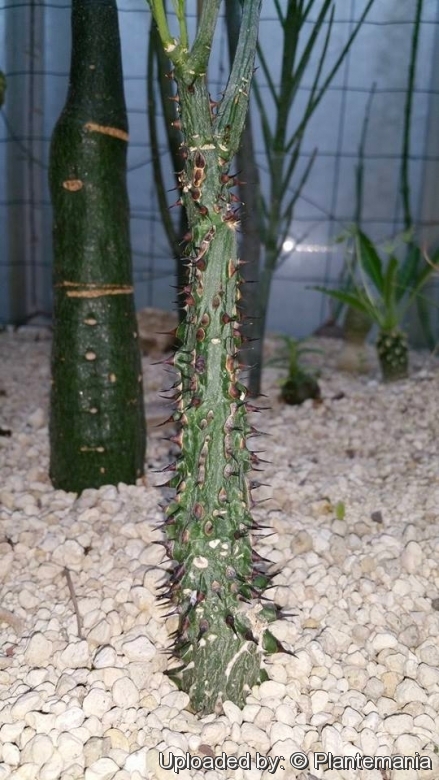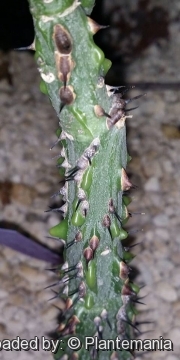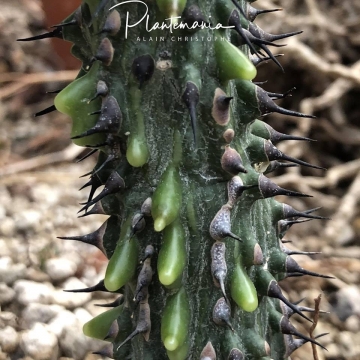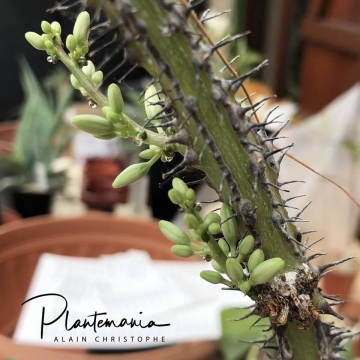Accepted Scientific Name: Adenia aculeata (Oliv.) Engl.
Bot. Jahrb. Syst. 14: 375 1891.

Modecca aculeata (Adenia aculeata) Photo by: © Plantemania
Origin and Habitat: Somalia, E Ethiopia, NE Kenya.
Altitude range: 500-750 metres above sea level (ssp. aculeata ) and 0-50m (ssp. manganiana).
Habitat and ecology: Adenia aculeataSN|33455]]SN|33455]] grows in semi-desertic, seasonally dry
habitats particularly on the limestone. The plateaus are mainly covered in grasses with scattered bushes. Thirsty herbivores may be attracted by the water storage stems of this plant that possess thorns or prickles, presumably in defense.
Synonyms:
See all synonyms of Adenia aculeata
back
Accepted name in llifle Database:Adenia aculeata (Oliv.) Engl.Bot. Jahrb. Syst. 14: 375 1891.Synonymy: 2
Accepted name in llifle Database:Adenia aculeata subs. inermis W.J.de WildeMeded. Landbouwhoogeschool Wageningen 71(18): 69 1971.Synonymy: 2
Accepted name in llifle Database:Adenia aculeata subs. manganiana (Chiov.) W.J.de WildeMeded. Landbouwhoogeschool Wageningen 71(18): 68 1971.Synonymy: 2
back
Description: Adenia aculeataSN|33455]]SN|33455]] is a large, deciduous, succulent liana, climbing with some tendrils, up to 20 m long, but usually much smaller, with an enlarged basal part of stem (caudex) up to 30 cm in diameter and particularly attractive for its stems randomly studded with black - an added attraction for the lover of cactus-like plants. Flowers are minute and unisexual yellowish-green or cream coloured.
Stems: Trunk semi-woody, pachycaul (water storing), up to 30 cm in diameter tappering above. Vines (branches) 2.5-5(-20) m, about 6-8 mm in diameter, with spines on ridges; spines closely set, 4- 20 mm long conical, simple or forked, brown, more or less broadened at the base, irregularly arranged in 4 or 5 ribs with the edges projecting, passing into 5 mm distant. Thorns and prickles are derived from dermal projections. Tendrils simple 5- 10 cm long.
Leaves: Absent for most of the year; 3-7-lobed (varying from slightly lobed to deeply dissected), base cordate, 5-nerved from base, 1-7 cm long, 1 -7.5 cm wide, often sandpapery. Petiole 0.5–8 cm long. Gland at base of blade single, partly on the petiole, narrowly campanulate, 11- 18 mm long, calyx-lobes free, lanceolate, 7–12 mm long. Petals free, lanceolate, 7–9 mm long.
Flowers: Yellowish-green in small axillary fascicles.
Male flower: In clusters of 2–40 flowers on about 10 cm long pedicel.
Female flowers: In clusters of 1–5 flowers, nearly sessile 8–12 mm long. Pistil 5–7 mm long. Styles shortly united at the base, without tendrils.
Fruit: Broadly ellipsoid, apiculate, 10-15 mm long, 8- 13 mm thick smooth, greenish-yellow, darker striped along the sutures.
Seeds: 10–15 per fruit, 3.5–4 mm in diameter.
Subspecies, varieties, forms and cultivars of plants belonging to the Adenia aculeata group
Bibliography: Major references and further lectures
1) M. Thulin “Flora Somalia”, Vol 1, 1993 [updated by M. Thulin 2008]
2) Urs Eggli “Illustrated Handbook of Succulent Plants: Dicotyledons” Springer Science & Business Media, 2002
3) “Medicinal Plants”, Volume 1 - PROTA, 2008
4) W. J. J. O. de Wildem “Flora of Tropical East Africa”, 1975
5) Henk Beentje, Joy Adamson, Dhan Bhanderi “Kenya trees, shrubs, and lianas” National Museums of Kenya, 1994
6) Keith Grantham, Paul Klaassen “The plantfinder's guide to cacti & other succulents” Timber Press, 18 May 1999
7) Gordon D. Rowley “The illustrated encyclopedia of succulents” Crown Publishers, 01 ago 1978
8) Hermann Jacobsen “Abromeitiella to Euphorbia” Blandford Press, 1960
9) David J. Hearn “Descriptive Anatomy and Evolutionary Patterns of Anatomical Diversification in Adenia (Passifloraceae)” Aliso: A Journal of Systematic and Evolutionary Botany. Volume 27, Issue 1 Article 3, 2009. University of Arizona.
 Adenia aculeata stem detail. (Adenia aculeata) Photo by: © Plantemania
Adenia aculeata stem detail. (Adenia aculeata) Photo by: © Plantemania Modecca aculeata (Adenia aculeata) Photo by: © Plantemania
Modecca aculeata (Adenia aculeata) Photo by: © Plantemania Adenia aculeata buds. (Adenia aculeata) Photo by: © Plantemania
Adenia aculeata buds. (Adenia aculeata) Photo by: © PlantemaniaSend a photo of this plant.The gallery now contains thousands of pictures, however it is possible to do even more. We are, of course, seeking photos of species not yet shown in the gallery but not only that, we are also looking for better pictures than those already present.
Read More...













